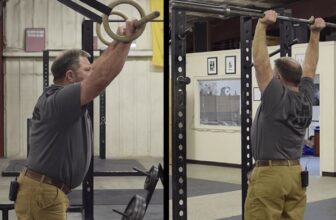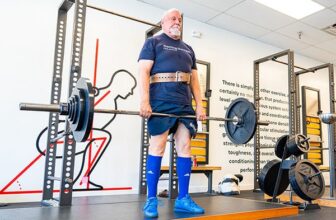
[adinserter block=”2″]
Over the years, there have been many articles written about the importance of keeping a training notebook. I’ve even mentioned it a few times myself. If you’re serious about your workouts, then it only makes sense that you should keep a training notebook, journal, diary, whatever name you want to apply to the written records of your workouts.
I’ve been recording my workouts from the time I was a teenager. Fortunately, at that time, most articles and books devoted to lifting encouraged people to log their workouts. I’m glad that I followed the prevailing advice of that particular time. I’ve benefitted greatly from keeping track of my workouts. Being able to look back and review training sessions has proven to be an invaluable asset not just for me, but for countless lifters over the years. Probably the only disadvantage is the accumulation of all these notebooks! They take up a couple of large cardboard boxes, and while non-lifters may classify these books as clutter, I can’t help but think what will happen to all these books when my time on Earth has passed? I’ve considered contacting my local congressman and inquiring if the Library of Congress would be interested. Perhaps I should start my own library of lifting, I certainly have enough material between my books, magazines, and training notebooks. Enough speculation, this article is about training notebooks.
There is one important point that I would like to make. The title for this article came from my good friend Steve Weiner. A couple of weeks ago, on New Year’s Day, I texted him a picture of my most recent training logs. One from 2023, and the new one for the new year 2024. Kind of like saying good-bye to the old, while welcoming in the new. Only there were no celebrations, no confetti, and Guy Lombardo definitely was not playing Auld Lang Syne ( for you younger readers google Guy Lombardo to find out about his association with New Year’s Eve). Anyway, when I texted the attached picture to Steve, his response was classic: “ The Most Valuable Tool in the Training Arsenal.” Truer words were never spoken! Luckily Steve, like me, was taught at a young age to record his workouts, and agrees with me about the importance of maintaining a written record of lifting sessions completed. I think many readers will agree with Steve’s assessment of training notebooks and their importance.
As you can see by the picture, I prefer to use a daily planner. I just like to keep things organized by date. The are many other effective- and cheaper- alternatives. The most basic approach would be simply using a notebook that you can purchase from any office supply store. It doesn’t have to be fancy, that’s for sure.
When I trained at Bruno’s, Larry used to use a simple spiral notebook. There was one member of Bruno’s who took it a little further. This guy was an older lifter, about ten years older than Larry, and he was a competitive powerlifter for a while. He was well known because he used to bring his own, personal Olympic bar to the gym. He drove a van, and would have the bar in the back of is van and bring it into the gym and use it. Nobody understood exactly why he did that, since his personal bar was the same, exact bar as the ones used in Bruno’s ( York ). This guy liked to draw attention to himself, and I guess that was reflected in his approach to his workouts. In addition to his own personal bar, he would bring his training notebook with him, and carry it from exercise to exercise. His training journal was a large, blue loose-leaf notebook, like the ones we dreaded in high school. He would make a big show of sitting down after every set, opening up his notebook, putting on a pair of reading glasses, then jotting down his most recent set. He would then place the book down with great care then proceed with his next set. It seemed like a carefully choreographed show, to say the least, and we used to get a kick out of it. I mean, he could have simply just remembered his poundages, or at least remembered the warm-up sets without writing them down. What a rip!
This brings me to an important point. Just what SHOULD you write down in your training journal? My answer to that is that there is no wrong answer. Obviously, you will enter your exercises, poundages, sets, reps. That’s self-explanatory. You can also comment on the relative ease or difficulty of each individual set. For example, Bench Press 315, 3 Sets of 10. First set easy, last two hard. Or all three sets easy, time to add weight. You get the point.
Some guys like to record the reps that they didn’t make. I never liked that approach. I’ve always felt that a training notebook should only reward those reps which are completed satisfactorily. Missed reps don’t deserve to be recorded. Obviously there will be those who adamantly disagree with me, and that’s fine.
There was a time, when I was trying to gain muscular weight, like most young lifters. During this time, I would also record my meals that were eaten that day. Additionally, I would also write down those supplements that were consumed during the course of the day. Needless to say Desiccated Liver used to appear regularly back then! Seriously, if you are trying to gain or lose weight, keeping track of your meals and your caloric intake can be of great assistance in making sure you reach your goals.
I have heard of some lifter who even take the time to record their resting heartrate upon waking up in the morning. Their reasoning for this is that since an elevated resting heartrate is a sign of over-training, it makes sense to keep track of this important marker. Again, it is a matter of individual preference.
As for recording your weight, if you are trying to add or drop some weight then it wouldn’t hurt to track your bodyweight. However, if you are going to do so, I wouldn’t do it every single day, since there will inevitably be variations. Maybe weigh yourself two or three times per week? And obviously make sure you utilize the same scale for each informal weigh-in. Using a bathroom scale one day, then using a Toledo gym scale another day is a good way to drive yourself crazy.
Many Olympic weightlifters used to record the total amount of tonnage lifted in each individual training session. The theory being that it is easy to measure your progress by comparing total tonnage from workout to workout. I even tried doing something like this a few times. It works well with the lifts. But when it gets to assistance movements, especially dumbbell exercises, then it gets increasingly more difficult to get an accurate picture of your progress when tonnage is the only yardstick.
The most important part of utilizing a training notebook is that it allows you to look back and compare yourself at various phases of your training. If you are preparing for a contest, then you can look back at old journals and compare your progress. When I was competing, I felt it was very important to “check the numbers” at various times throughout a training cycle. It is especially important for drug-free lifters because of the inevitable days when the weights “feel heavy.” Those doldrum days when you just don’t have it can be compared to similar workouts for the purpose of getting yourself out of a rut.
If you are serious about your lifting, then do yourself a big favor and make sure that you take advantage of the most valuable tool in the training arsenal. You’ll be glad that you did.
[adinserter block=”2″]
Credit : Source Post






